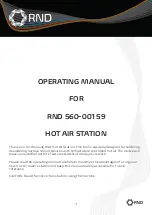
12
Tip Selection & Use
1. HEAT TRANSFER: Maximize thermal
transfer by selecting the shortest, fattest tip with
the largest surface contact area which
appropriately fits the work. Keep the tip clean
and freshly tinned, and clean the work of oxides
or other residues.
When soldering, angle the tip to the joint so that
there is maximum surface contact area. The use
of a “solder bridge” to enhance “thermal
linkage” will also improve heat transfer.
Handpiece Tips
5. HANDPIECES: The SP-2A Sodr-Pen (which comes standard with your
ST 40A system) uses 3/16" shank tips providing maximum heat transfer
for Surface Mount and multilayer board applications.
The optional SP-1A Sodr-Pen uses 1/8" shank tips and features a slimmer,
more compact heater for easier access on densely populated assemblies.
2. TIP ACCESS & VISIBILITY: The tip selected must easily contact the
joint without touching the board substrate, adjacent components or other
solder joints.
Longer, thinner, more tapered tips allow the operator to more easily
access and view the solder joint during soldering for better process
control. However, such tips generally have much less heat transfer
ability than shorter, fatter tips.
3. TIP TEMPERATURE: Use the lowest tip temperature which will
achieve rapid yet controllable melt of the entire joint(s). Begin with a
temperature of 316°C (600°F) and adjust as necessary to suit the
particular application and operator skill level. Lower tip temperatures
reduce the risk of damage and increase tip life.
4. SMT REMOVAL: Tips for SMT removal
applications must fit over (or around) the
component body, and contact all the solder
joints at once. When all the solder joints reflow
completely, remove the component.
Summary of Contents for ST 40A
Page 1: ...Operation Maintenance Manual ST 40A Systems ...
Page 17: ...15 ...
































